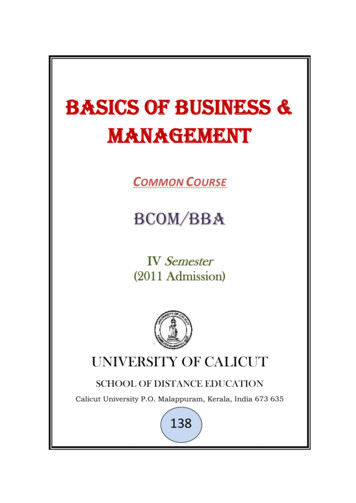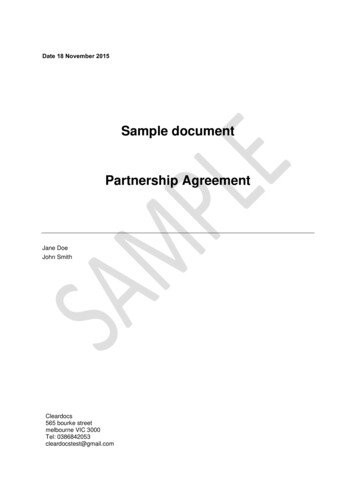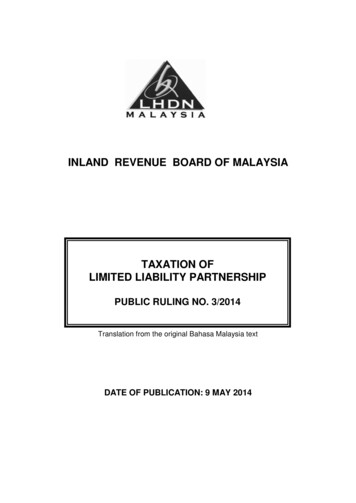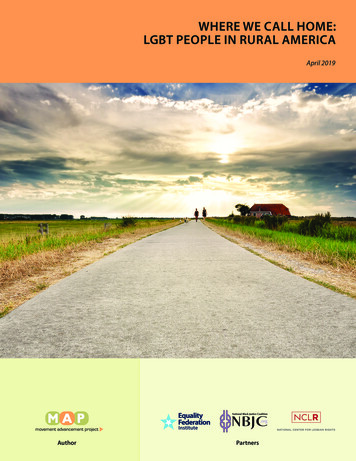
Transcription
Original ArticleDOI: 10.31083/jomh.v16i4.222THE EFFECTS OF HOMOPHOBIA, PARTNERSHIP, SEXUAL SELF-LABELS,AND INVOLVEMENT OF LGBT CENTER ACTIVITY ON COMING OUTIN VARIOUS SOCIAL RELATIONSHIPS AMONG CHINESE GAY MENZhengjia Ren1‡, Xinli Chi2‡, Chunsong Yang3, Yanhong Liu4‡‡, Renjie Zhang5‡‡Department of Clinical Psychology, Southwest Hospital, The First Hospital Affiliated to Army MedicalUniversity (Third Military Medical University), Chongqing, China1College of Psychology, Shenzhen Key Laboratory of Affective and Social Cognitive Science, College ofPsychology, Shenzhen University, Shenzhen, China23Department of Pharmacy, West China Second Hospital, Sichuan University, Chengdu, China4Department of Psychology, Hebei University of Chinese Medicine, Hebei, ChinaDepartment of Integrated Management, Zhejiang Provincial Center for Disease Control and Prevention,Zhejiang, China5‡Zhengjia Ren and Xinli Chi contributed equally to this study.‡‡The corresponding two authors (Renjie Zhang and Yanhong Liu) also contributed equally to this study.Corresponding Authors: Renjie Zhang: rjzhang@cdc.zj.cn; Yanhong Liu: yanhongliu2387@163.comSubmitted: 20 January 2020. Accepted: 09 September 2020. Published: 01 October 2020.ABSTRACTObjectivesThe present study explored the factors that influenced the likelihood of 503 Chinese gay men’s choice ofcoming out in different social relationships in a Chinese cultural context.MethodsThe current study reports on data from a cross-sectional survey analyzing the relationships between thechoice of coming out of a homosexual individual’s social relationships and its relation to demographics, internalized homophobia, sexual self-label, and attendance at lesbian, gay, bisexual and transgender(LGBT) center activity using a multivariate logistic regression model.J Mens Health Vol 16(4):e1–e17; 01 October 2020This article is distributed under the terms of the Creative Commons Attribution-NonCommercial 4.0 International License. 2020 Zhengjia Ren et al.e1
Factors affecting Chinese gays to turn up to different social relations in Chinese cultural contextResultsOther-oriented identity was a predictor of outness to close friends, friends, relatives, and colleagues. Thegreater the frequency of attendance to LGBT center activities, the more likely the participants were tochoose to come out to their parents, relative, and friends. Other demographic data, such as age, education,number of siblings, and partnership, are also factors related to outness in different social relationships.ConclusionsThe factors related to coming out are varied in different social relationships, which implies that individualsuse different principles in different social relationships. The present study provides further evidence thatmental health professionals should work with LGBT centers to help homosexual individuals with their identity development and to develop individualized assistance strategies based on different social relationships.Keywords: Chinese; coming out; gay men; LGBTINTRODUCTIONself-identity and psychosocial well-being.4,5 Previousresearch notes that internalized homophobia is oneof the most important factors that impinges on theidentity and the process of coming out to oneselfand one’s social surroundings.6–8In Chinese culture, homophobia involves notonly individual components but also the sociocultural and family-related components of internalized homophobia.9 Several scholars have claimedthat homosexual individuals in East Asian culturesdescribe feelings of guilt and concerns about bringing shame to their parents and family and failing tofulfill the responsibilities of heterosexual marriageand continuation of family line, which is valued bythe culture and shapes the way homosexual individuals perceive their sexual identities.10,11 In China,gay marriage has not been fully accepted, and coming out is treated as a refusal to produce a maleheir, which typically leads to dishonor and shameto one’s parents and family.12 Coming-out behaviorin Eastern cultures may lead to discrimination andmarginalization in the family, and at workplace,community, and society. Some disclosures maycause harm in the lives of homosexual individuals,such as family crisis, dismissal from the household, parental rejection, loss of friends, or the lossof promotion or mistreatment at the workplace.13–17In the Western context, coming out with regard toone’s sexual orientation to oneself and/or to others isIn different sociocultural contexts, homosexual individuals experience unique stressors, suchas homophobia, societal discrimination, and limitedsocial and institutional support because of their sexual orientations.1Although attitudes toward sexual minorities inChina have become increasingly open in the pastdecades, the underlying sociocultural and familyideologies often produce stress in sexual minoritygroups.2 In China, the same-sex behavior and desireare still treated as pathological, immoral, and evencriminal behavior, and discrimination and prejudicetoward homosexual individuals permeate the societal and individual levels. In China, homosexual menare usually stigmatized as being feminine. In particular, bottoms are usually considered to play submissive, protected, and insertive sexual roles thatare likely to be compared to the roles of a wife ina heterosexual marriage. Sexism exists not only inthe public but also in the lesbian, gay, bisexual andtransgender (LGBT) population. Previous researchhas found that gay men who exhibited higher sexismwere more likely to identify as tops than bottoms.3The perpetuation of negative sociocultural stereotypes about homosexual behavior and traditionalmasculine norms has been internalized in the mindsof sexual minorities, and these stereotypes and sexism have a profound impact on sexual minorities’J Mens Health Vol 16(4):e1–e17; 01 October 2020This article is distributed under the terms of the Creative Commons Attribution-NonCommercial 4.0 International License. 2020 Zhengjia Ren et al.e2
Factors affecting Chinese gays to turn up to different social relations in Chinese cultural contextused as evidence of gay developmental progression,and identity disclosure is profoundly influenced bythe Western sociocultural and political context.18Previous studies have questioned the universality ofmodels of gay identity development across differentsociocultural and political and ethnic contexts.19Different sociocultural and political environments influence the behaviors of every individual ina culture. Coming out as gay is a social process thatinvolves various social, cultural, psychological anddemographic factors that may influence an individual’s outness choices.20 Griffith and Hebl found thatan employer’s positive attitudes toward homosexuality are associated with disclosure behaviors ofhomosexual individuals at work.21 Some researchershave found that coming out to family members correlates significantly and negatively with internalized homophobia.5 Another study has shown thatcoming out to one’s best friend was predicted byinternalized sexual stigma.22 Acceptance of sexualorientation is the strongest predictor of comfortabout the disclosure of individuals’ own sexualorientation to their mother, father, and the closestfriend.23 Interestingly, several studies have claimedthat homophobia is not related to the outness to parents.24,25 Other studies have claimed that good socialsupport from partners and LGBT-identified friendsand communities is associated with disclosure toothers.26–28 These different results imply that thereasons for outness may differ in different socialrelationships.Converging sociocultural factors make itdifficult for sexual minorities to come out. A previous study failed to assess the components ofculturally related internalized homophobia andthus may have failed to understand gay men’schoices in relation to coming-out experiences.The current study attempts to measure the correlation between important aspects of the culturallyrelated construct of homophobia, partnership, sexual self-labels, involvement of LGBT centers, andother demographic data and gay men’s choices tocome out.METHODSAnonymous online survey links were distributed through multiple channels from May 2017 toJune 2018. The researchers posted online description of the study’s objectives and benefits, confidentiality guarantee, and the consent form. Thesurvey was initiated in different social networks ofChina, such as WeChat group and several socialmedia groups. The researchers also invited participants to distribute the link of online questionnairesto other homosexual individuals through their ownsocial media networks (e.g. WeChat). The solicitation was also posted on China’s different LGBTcenters.The study was reviewed and approved by acommittee at Southwest Hospital. The data werecollected through an anonymous, Internet-basedsurvey platform. The participants in this study weregay men who were Chinese citizens (N 503). Theother baseline characteristics of the cohort are presented in the Appendix.Assessments and MeasurementSocio-demographic characteristicsThe questionnaire included the participants’age, sex, education, religion, occupation, area theparticipant was brought up, income, sibling situation (only child, with brother, with sister, or withbrother and sister), and ethnicity.Attendance at LGBT center activitiesOne question asked was as to how frequentlythe participants engaged in activities at local LGBTcenters. The items were rated from 1 (never) to 5(very frequently).Chinese internalized homophobia scaleThe current research used the Chinese internalized homophobia scale9 to assess the participants’ experience of internalized homophobia.The scale includes three subscales: internalizedheteronormativity (the belief that homosexualityJ Mens Health Vol 16(4):e1–e17; 01 October 2020This article is distributed under the terms of the Creative Commons Attribution-NonCommercial 4.0 International License. 2020 Zhengjia Ren et al.e3
Factors affecting Chinese gays to turn up to different social relations in Chinese cultural contextis abnormal), family-oriented identity (the ideology of maintaining filial piety, family first, andcarrying on the family line), and socially orientedidentity (the belief about how other people thinkabout me or my identity and my family). The itemswere rated from 1 (totally disagree) to 5 (totallyagree). The reliability was 0.855 for the entirescale, 0.715 for the internalized heteronormativity subscale, 0.713 for the family-oriented identitysubscale, and 0.77 for the socially oriented identitysubscale.FUNDINGThe study was supported by the Medical andHealth Science Technology Project of ZhejiangProvince (2019KY055), Zhejiang, China.RESULTSBasic CharacteristicsA total of 503 participants were included. Withregard to ethnicity, 93.6% (471/503) of the participants were of Han nationality, and the majority(77.5%, 390/503) had no religious beliefs. Withregard to the area where the participants werebrought up, 22.1% participants were from villages (111/503), 33.4% were from towns (168/503),and 44.5% were from cities (224/503). Additionaldetailed characteristics of the included participantsare summarized in Table 1.Coming outFour questions were used to assess whether(yes or no) the respondents were out (“Chu Gui” inChinese, which literally means coming out of thecloset) about their sexual identity to their parents,close friends, friends, relatives, classmates, or colleagues at their work environment.The Prevalence of Coming OutOverall, the percentages of coming out were15.1% (76/503) for parents, 69% (347/503) for closefriends, 16.9% (85/503) for friends, 9.1% (46/503)for relatives, and 6.8% (34/503) for work colleagues.Additional detailed characteristics of the includedparticipants are summarized in Tables A1–A3.Sexual self-labelA single question was asked to the participantsto self-identify their sexual label: “Do you think ofyourself as a ‘top’, ‘versatile’, or ‘bottom’?” Theparticipants selected their responses from the list ofabove three options.Statistical analysesA total of 503 participants were included in theanalysis. We used the chi square or t test to investigate group differences for categorical variables andvariance analysis for quantitative variables. First,we conducted univariate analysis and includedfactors with univariate p 0.10 in the multivariatelogistic regression model. Multivariate analysis wasperformed to separately examine the relative contribution of potential predictors of coming out to therespondent’s parents, close friends, friends, relatives, and colleagues at the work environment usingbinary logistic regression. A p-value 0.05 wasassumed to be statistically significant. Data analyses were performed using SPSS version 22 (SPSSInc., Chicago, IL, USA).Factors Associated with Coming OutIn the univariate analysis, occupation, age,area where the participant was brought up, siblings,attendance to LGBT center activities, and family-oriented identity were significantly associatedwith disclosure to parents. These seven factors withunivariate p 0.10 were included in the multivariate regression model. The results of multivariateanalysis showed that having a sibling (odds ratio[OR] 0.343, 95% confidence interval [CI] 0.130–0.880) was associated with disclosure to parents.The results of multivariate analysis further showedthat very frequent attendance to LGBT center activities (OR 2.831; 95% CI 1.043–7.682), somewhatfrequent attendance to LGBT center activitiesJ Mens Health Vol 16(4):e1–e17; 01 October 2020This article is distributed under the terms of the Creative Commons Attribution-NonCommercial 4.0 International License. 2020 Zhengjia Ren et al.e4
Factors affecting Chinese gays to turn up to different social relations in Chinese cultural contextTABLE 1Detailed Summary of Characteristics of Participants.VariableWorkerOccupationProfessional 495% mentAge (years)Place brought upAttendance at LGBTcenter 60.416–4.28831–4316–20TownCityVillageVery ��2.4730.0290.0421.0290.949–1.117Somewhat frequentlyOccasionallySomewhat infrequentlyNeverSiblingsBrotherSisterBothOnly childFamily-oriented , lesbian, gay, bisexualand transgender; OR, odds ratio; CI, confidence interval; B, regression coefficient; SE, standarderror; Wald, wald test statistic(OR 3.284; 95% CI 1.394–7.656), and somewhatinfrequent attendance to LGBT center activities(OR 2.166; 95% CI 1.138–4.121) increased thelikelihood of coming out to parents. Regressionresults of the associations between different demographic data, psychosocial factors, and coming outto parents are reported in Table 1.In the univariate analysis, ethnicity, having ahomosexual partner, sexual self-label, area wherethe participant was brought up, internalized heteronormativity, and socially oriented identity weresignificantly associated with disclosure to closefriends. These factors with univariate p 0.10 wereincluded in the multivariate regression model. Theresults of multivariate analysis showed that havinga homosexual partner (OR 1.936, 95% CI 1.139–3.292), sexual self-label (OR 0.452, 95% CI 0.241–0.845), and socially oriented identity (OR 0.935,95% CI 0.877–0.997) were associated with comingout to close friends. Regression results of the associations between different demographic data, psychosocial factors, and coming out to close friends arereported in Table 2.In univariate analysis, attendance to LGBTcenter activities, area where the participant wasbrought up, internalized heteronormativity, sociallyJ Mens Health Vol 16(4):e1–e17; 01 October 2020This article is distributed under the terms of the Creative Commons Attribution-NonCommercial 4.0 International License. 2020 Zhengjia Ren et al.e5
Factors affecting Chinese gays to turn up to different social relations in Chinese cultural contextTABLE 2Logistic Regression Analysis of Influencing Factors for Coming Out to Close Friends.EthnicityHaving a homosexual partnerPlace brought upSexual self-labelVariableSocially VersatileInternalized heteronormativitySocially oriented identityB0.9530.661SE0.508Wald3.529OR2.59495% CI0.959–7.0150.271Reference5.950 0.015 ence3.849 0.050 1.7110.251 0.616 1.136Reference3.242 0.072 0.6156.181 0.013 0.452Reference2.268 0.132 0.9424.159 0.041 ��0.8450.872–1.0180.877–0.997OR, odds ratio; CI, confidence interval; B, regression coefficient; SE, standard error; Wald, wald test statistic.oriented identity, and family-oriented identity weresignificantly associated with disclosure to friends.These factors with univariate p 0.10 were includedin the multivariate regression model. The results ofmultivariate analysis showed that internalized heteronormativity (OR 0.847, 95% CI 0.758–0.946)and socially oriented identity (OR 0.815, 95% CI0.738–0.899) were associated with disclosure ofthe participants’ sexual orientation to friends. Theresults of multivariate analysis showed that somewhat frequent attendance to LGBT center activities(OR 2.680; 95% CI 1.170–6.136) and frequentattendance to LGBT center activities (OR 3.081;95% CI 1.139–8.335) increased the likelihood ofcoming out to friends. Regression results of theassociations between different demographic data,psychosocial factors, and coming out to friends arereported in Table 3.In the univariate analysis, attendance at anLGBT center, area where the participant wasbrought up, education, internalized heteronormativity, socially oriented identity, and family-oriented identity were significantly associated withdisclosure to relatives. These factors with univariate p 0.10 were included in the multivariate regression model. The results of multivariateanalysis showed that education (OR 0.235, 95%CI 0.08–0.693), area where the participant wasbrought up (OR 3.363, 95% CI 1.089–10.384),frequency of attendance to LGBT center activities(OR 4.309, 95% CI 1.464–12.686), and sociallyoriented identity (OR 0.863, 95% CI 0.764–0.974)were associated with the likelihood of coming outto relatives. Regression results of the associationsbetween different demographic data, psychosocialfactors, and coming out to relatives are reported inTable 4.In the univariate analysis, education, age, internalized heteronormativity, socially oriented identity, and family-oriented identity were significantlyassociated with disclosure to colleagues. Theseseven factors with univariate p 0.10 were includedin the multivariate regression model. The results ofmultivariate analysis showed that age (OR 0.325,95% CI 0.108–0.979), education (OR 4.395, 95%CI 1.264–15.281), and socially oriented identityJ Mens Health Vol 16(4):e1–e17; 01 October 2020This article is distributed under the terms of the Creative Commons Attribution-NonCommercial 4.0 International License. 2020 Zhengjia Ren et al.e6
Factors affecting Chinese gays to turn up to different social relations in Chinese cultural contextTABLE 3Logistic Regression Analysis of Influencing Factors for Coming Out to Friends.VariablePlace brought upTownCityVillageAttendance atVery frequentlyLGBT centerSomewhat frequentlyactivitiesOccasionallySomewhat infrequentlyNeverInternalized heteronormativityFamily-oriented identitySocially oriented 0.0030.0510.82216.724 0.000OR0.7131.33195% .899LGBT, lesbian, gay, bisexualand transgender; OR, odds ratio; CI, confidence interval.TABLE 4Logistic Regression Analysis of Influencing Factors for Coming Out to Relatives.VariableEducationAbove universityUniversityBelow universityPlace brought upCityTownVillageAttendance atVery frequentlyLGBT centerSomewhat frequentlyactivitiesOccasionallySomewhat infrequentlyNeverInternalized heteronormativityFamily-oriented identitySocially oriented 0.0790.028–0.1480.0690.0670.062Waldp6.8884 ce1.3250.2500.1770.6745.7070.017OR0.2350.88095% 0.807–1.0570.902–1.1730.764–0.974LGBT, lesbian, gay, bisexualand transgender; OR, odds ratio; CI, confidence interval; B, regression coefficient; SE, standarderror; Wald, wald test statistic.(OR 0.667, 95% CI 0.569–0.783) were associatedwith disclosure to colleagues. Regression resultsof the associations between different demographicdata, psychosocial factors, and coming out to colleagues are reported in Table 5.DISCUSSIONThe study demonstrates that different types ofsocial relationships affect communication about sexual orientation.29 The factors related to coming outJ Mens Health Vol 16(4):e1–e17; 01 October 2020This article is distributed under the terms of the Creative Commons Attribution-NonCommercial 4.0 International License. 2020 Zhengjia Ren et al.e7
Factors affecting Chinese gays to turn up to different social relations in Chinese cultural contextTABLE 5Logistic Regression Analysis of Influencing Factors for Coming Out to Most People.VariableAge (years)31–4320–3016–20EducationAbove universityUniversityBelow universityInternalized heteronormativityFamily-oriented identitySocially oriented 5% �1.1870.569–0.783OR, odds ratio; CI, confidence interval; B, regression coefficient; SE, standard error; Wald, wald test statistic.vary in different social relationships, which may bedue to the use of different principles toward different social relationships. These findings are inconsistent with the results of a previous study suggestingthat gay men with higher internalized heteronormativity are less likely to come out to family members,relatives, and other social networks.5,30 Our researchfound that only internalized heteronormativity wasnegatively related to coming out to friends. Thecurrent research further revealed that gay menwith higher socially oriented homophobia were lesslikely to come out to their friends, close friends,colleagues, and relatives, but there was no relationto coming out to parents. Hwang31 identified threetypical relationship patterns in Chinese society:expressive ties, mixed ties, and instrumental ties.In expressive ties, the family tends to satisfy eachother’s needs and maintains conflict within the family. Instrumental ties are those which are establishedwith strangers for the purpose of obtaining resourcesand emphasize equity principles. Mixed ties arerelated to acquaintances and emphasize reciprocalprinciples.31 Relationships with parents are based onexpressive ties and are different from other socialinteractions. In social interactions other than thosewith parents, the individual privileges and cultivatesidentification with relevant others, which means thathow the “other” thinks about oneself must alwaysbe taken into account.32 The relationships betweenclose friends, friends, relatives, and colleagues areother-oriented; in these relationships, homosexualindividuals are concerned about how other peoplethink about them and their family, which pushesthem to conceal their sexual orientation in public.33Thus, identity of other-oriented makes an individual less likely to come out to close friends, friends,relatives, and colleagues. Another explanation forthis finding is that an underlying other-oriented ideology makes individuals within a certain contextmore vulnerable to others’ opinions about them;thus, homosexual individuals encounter significantdifficulties and psychological barriers in disclosingtheir sexual orientation. Furthermore, homosexuality is still largely unaccepted by the public; comingout may lead to a loss of face for the family andthe individual, which may contribute to rejection orstigmatization by the community and could lead to atype of “social death.”10 Therefore, socially orientedhomophobia could discourage homosexual individuals from coming out to their social networks.The current research is not consistent with ourintuitive thinking about gay men who have brothers who can continue their family line and take onthe responsibility of the family, which may makeit easier for homosexual individuals to come outto their parents. This research has found that gayJ Mens Health Vol 16(4):e1–e17; 01 October 2020This article is distributed under the terms of the Creative Commons Attribution-NonCommercial 4.0 International License. 2020 Zhengjia Ren et al.e8
Factors affecting Chinese gays to turn up to different social relations in Chinese cultural contextmen are less likely to come out to their parents ifthey have lived in an environment with a brothercompared to an only-child family. The underlyingreason may be that gay men who have brothers mayalso have families with rigid gender roles for men,such as an emphasis on masculinity. Gay men maybe treated as feminine, which makes it very difficult for them to come out to their parents. Anotherinteresting finding involves sexual self-labels: menwho identify as tops are less likely to come out toclose friends, which suggests that their self-identity as a top in the same-sex relationships impliesself-ascribed masculinity.34 Homosexual behaviormay be ascribed to femininity, which may preventthese men from coming out to their close friends.The current research has found that having astable relationship and many LGBT contacts couldaffect individuals’ choice to disclose their sexualorientation. Specifically, having many LGBT contacts is positively associated with coming out toparents, friends, and relatives. There are severalpotential explanations for this result. LGBT centersmay provide emotional and professional support tohelp participants learn coping strategies to addressthe issues of coming out, and involvement withLGBT centers may provide emotional and socialsupport that can buffer the eventual negative consequences related to the issue of coming out.35,36 Theresults are consistent with previous minority socialcontacts theory, which emphasizes that throughthe process of social comparison, intergroup contact can help homosexual individuals reduce theirown prejudice toward their orientation and providesupport to cope with potential barriers to comingout.37,38 The current research has found that havinga stable relationship may make it easier to concealone’s sexual identity toward close friends, althoughan intimate partner may provide support for homosexual individuals to come out to close friends.Homosexual individuals who grow up in citiesare more likely to come out to their relatives, whichimplies that the openness of their growth environment leads to fewer stereotypes and less stigmatoward sexual minorities, which can help them to beless frightened about coming out to their relatives.Gay men aged 21–30 years have much moredifficulty coming out to their colleagues. This ageperiod is a critical stage of career development thatmay make individuals concerned about how otherpeople think about them or about their career development. An interesting result is that gay men witha university education find it easier to come out totheir colleagues than do gay men with a below-university education. Gay men may find it much easier to come out to colleagues because they feel thatthey are in an equal relationship. Coming out to colleagues involves personal issues that are not relatedto family members. Gay men with a background ofgraduate education find it much more difficult tocome out to their relatives than do gay men with abelow-university education level. This implies thatgay men in a family system with higher educationmay have much higher expectations in the family,which may make them reject coming out to maintain a “good” image for their relatives. Furthermore,coming out to relatives involves not only personalissues but also issues of family reputation. It isalso worth noting that because of the restrictionsand stigmatization of homosexuality, men whohave sex with men (MSM) often marry to concealtheir homosexuality and to deal with their families’expectations. Wang et al. estimated that there are14 million mixed-orientation marriages betweenhomosexual men and heterosexual wives in China.39Considering the age range of our subjects, maritalstatus could be an important factor affecting theirchoice of coming out. Unfortunately, our onlinesurvey did not collect information on marital status;thus, we suggest that the future research should further explore the relationship between MSMs’ marital status and their choice of coming out.CONCLUSIONSOur results indicate a significant associationbetween coming out and socially or
Factors affecting Chinese gays to turn up to different social relations in Chinese cultural context e4 Mens Health ol 16(4):e1–e17; 01 October 2020 This article is distributed under the terms of the Creative Commons Attribution-Non Commercial 4.0 International License. 2020 Zhengjia Ren e










